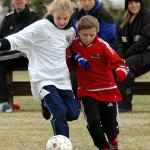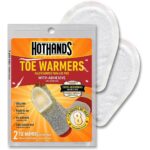 There will be some cold days when the girls may want (or need) to wear more than their usual practice gear or game day uniform. When dressed properly, playing soccer in cold weather is fun! But it can be miserable if a player isn’t prepared for the cold.
There will be some cold days when the girls may want (or need) to wear more than their usual practice gear or game day uniform. When dressed properly, playing soccer in cold weather is fun! But it can be miserable if a player isn’t prepared for the cold.
Head:
- We recommend thermal headbands. Ski-style hats tend to obscure vision or fall off too easily, but they’re OK for warm-up or when subbing out. Earmuffs also fall off too easily and aren’t recommended on the field, but they are OK when subbing out.
Upper body:
Practice sessions:
 Go with layers, starting with a moisture-wicking first layer, followed by a fleece or thermal second layer (such as an Adidas “Climawarm” shirt or an Under Armour “cold gear” shirt), then a practice jersey and a jacket.
Go with layers, starting with a moisture-wicking first layer, followed by a fleece or thermal second layer (such as an Adidas “Climawarm” shirt or an Under Armour “cold gear” shirt), then a practice jersey and a jacket.- We don’t recommend hoodies because the hood presents a potential danger to the player. (Another player’s hand or foot could accidentally get caught in the hood and yank a player down or twist her neck.)
Game days:
 Go with layers underneath the uniform shirt. Start with a moisture-wicking first layer, followed by a fleece or thermal second layer (such as an Adidas “Climawarm” shirt or an Under Armour “cold gear” shirt). If it’s extremely cold, feel free to add another layer, finishing with the uniform shirt on top. Girls should also wear a jacket over their uniform shirt for warm-up time and while subbing out.
Go with layers underneath the uniform shirt. Start with a moisture-wicking first layer, followed by a fleece or thermal second layer (such as an Adidas “Climawarm” shirt or an Under Armour “cold gear” shirt). If it’s extremely cold, feel free to add another layer, finishing with the uniform shirt on top. Girls should also wear a jacket over their uniform shirt for warm-up time and while subbing out.- Goalkeepers can wear warm-up jackets while playing, but field players need their numbered uniform shirt as their outer layer.
- Hoodies aren’t typically allowed on-field during game days because the hood presents a potential danger to the player. (Another player’s hand or foot could accidentally get caught in the hood and yank a player down or twist her neck.) But players can wear hoodies when subbing out.
- 2012 fine print re: colors: FIFA (soccer’s governing body) added a specification to the laws regarding player equipment: “If undergarments are worn, the color of the sleeve must be the same main color as the sleeve of the jersey or shirt“. In our youth Academy world, we don’t expect a ref to disqualify a player due to sleeve color, but be aware the laws of the game would support such a decision.
Hands:
- Any soccer player can wear gloves — not just goalkeepers! We recommend gloves that have some “grippy” material on the fingers to help with throw-ins.
Lower body:
Practice sessions:
- Wear warm-up pants, and / or wear compression shorts, tights or leggings under the shorts.
Game days:
- Girls can wear warm-up pants during game day warm-up or when subbing out. We want them wearing their shorts as their outer layer during game days. Coaches may waive the “no pants” rule in extreme cold.
- Wear compression shorts, tights or leggings under the uniform shorts. We recommend blue, black or white color. (Tights or leggings are preferred to pants in cold weather because they won’t potentially catch on a player’s cleats and trip her. If a player wears warm-up pants, she should tuck the pants hems into her socks to avoid accidental trips.)
- 2012 fine print re: colors: FIFA (soccer’s governing body) added a specification to the laws regarding player equipment: “If under shorts or tights are worn, they must be of the same main color as the shorts“. In our youth Academy world, we don’t expect a ref to disqualify a player due to the color of her tights, but be aware the laws of the game would support such a decision.
Feet:
 When it gets really cold, you may want to add some extra foot protection. Most people are familiar with the hand warmer pouches you can put inside pockets or gloves. The same companies also make toe warmers. These are half-moon shaped with adhesive backing. You apply them to the bottom of your socks under the toe area. They work! And they’re very thin, so they don’t affect the fit of shoes. These are available at sporting goods and camping supply stores for $1-2 per pair. (Only recommended for extremely cold days, such as wind chills below 20.)
When it gets really cold, you may want to add some extra foot protection. Most people are familiar with the hand warmer pouches you can put inside pockets or gloves. The same companies also make toe warmers. These are half-moon shaped with adhesive backing. You apply them to the bottom of your socks under the toe area. They work! And they’re very thin, so they don’t affect the fit of shoes. These are available at sporting goods and camping supply stores for $1-2 per pair. (Only recommended for extremely cold days, such as wind chills below 20.)


 Go with layers underneath the uniform shirt. Start with a moisture-wicking first layer, followed by a fleece or thermal second layer (such as an Adidas “Climawarm” shirt or an Under Armour “cold gear” shirt). If it’s extremely cold, feel free to add another layer, finishing with the uniform shirt on top. Girls should also wear a jacket over their uniform shirt for warm-up time and while subbing out.
Go with layers underneath the uniform shirt. Start with a moisture-wicking first layer, followed by a fleece or thermal second layer (such as an Adidas “Climawarm” shirt or an Under Armour “cold gear” shirt). If it’s extremely cold, feel free to add another layer, finishing with the uniform shirt on top. Girls should also wear a jacket over their uniform shirt for warm-up time and while subbing out.